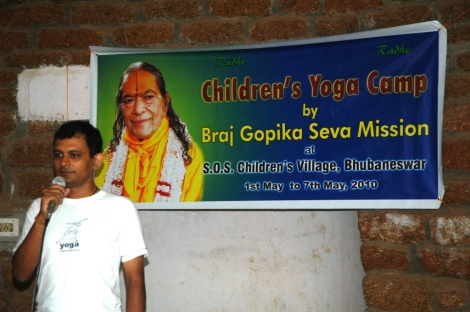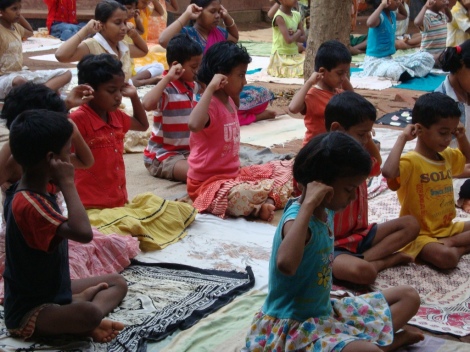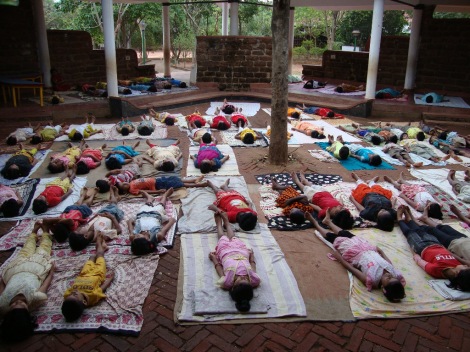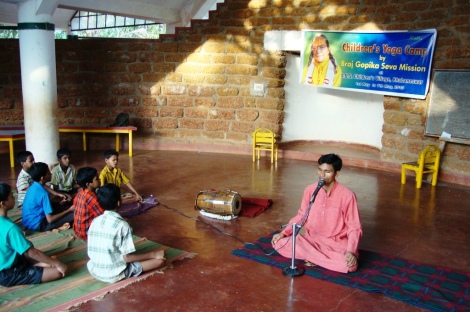We did a yoga camp for the children of S.O.S. Village, Bhubaneswar and here is something on that program.
I have been meaning to do something like this for a long time. One day, nearly a month back, I had an urge to go to the Village and had a word with the administrators there. They were very keen on a yoga program for the children in the Village.
S.O.S. is a worldwide NGO, and according to a website – the organization’s work focuses on abandoned, destitute and orphaned children requiring family-based child care. Millions of children worldwide are living without their biological families for a variety of reasons including:
- parental separation,
- domestic violence and neglect
- they have lost their parents due to war or natural catastrophes
- disease
A little more about the Children’s Village – this was founded by Hermann Gmeiner, an Austrian, after WW2. He had the misfortune of losing his parents and his numerous siblings were brought up by the sacrifice of their elder sister, who remained a spinster.
The horrors of the war and the great numbers of orphans and childless women that were the consequences of this bloodletting got him to start this organization. It works on a beautiful concept: there are plenty of children who don’t have the luxury of a family. There are, as well, many women who have no children, or are in an unfortunate situation in life. The organization works to bring the two together – the children have a home with a ‘mother’ and the women get shelter and get to work on the upbringing of children, a rewarding work for sure.
It is not a school; it is a home for the children. The one in Bhubaneswar has about 20 homes, each with a mother who takes care of the nearly ten or twelve children. These ladies get a thorough training in SOS’s own institute in Delhi for two years on child care.
It is fashionable these days to decry the achievements of NGOs and spiritual organizations. If one goes by popular media, NGOs are fronts for accumulating money and spiritual organization are even worse! However, I believe that SOS is doing a great job. Most of these children are either orphans or their parents cannot or will not support them. The organization provides them with good homes (they live better than most middle class children), good education (some of them go to the best schools in my hometown) and it also arranges for their marriages after they finish their studies. Many of the children are pursuing engineering, medicine and other vocations – all at the expense of the organization.
To my reckoning S.O.S. spends not less than Rs. 5,000 (USD 100) a month on each child. This is considerable money in India and a lot more than what an average family can spend on a child.
S.O.S. has more than 40 such villages in India.
You will find more about it on this link http://www.soscvindia.org/charity/index.php
When I proposed the idea to the members of my ashram, everyone thought that it would be a great idea and we got the go ahead to conduct a seven day program. This kind of activity is complimentary to our objectives and what is more, it is great fun to be around with bubbly children! It is our dream to set up a gurukula, a residential school for children, someday.
The classes were from 5 am to 6:30 am daily and Gurucharan Bhai of my ashram and I were the instructors. We took turns at instructing and demonstrating the poses. Apart from the yoga and pranayama practices, we used to start the session and end it with kirtan.
Kirtan is the devotional chanting of the Lord’s name. Of course, it is a devotional practice; but if you look at it from another view, it is a great ice-breaker and does wonders to improve the mental disposition of the individual.
A lot of people (including me, before 1997), especially the educated ones are quite stiff about singing and chanting with abandon. Not so the children; they responded to the kirtan with gusto and it was wonderful to behold. By the way, I was the lead singer and drummer, though I am good at neither! In any case, the point is not a musical rendition of the songs, but to plunge into it with enthusiasm.
We had a great time. On arriving at five in the morning, we would find someone waiting for us. In particular, there was a nice child called Devraj, who would be at the gate for sure. The children would clean the place, set up the sound system, and roll the mats – all before our arrival at 5 am.
Devraj is a very bright student; he is in Standard V and achieved 100% in Math in his school and stood first in his class of 93 students. Mind you, this is a normal school and there are children of all backgrounds in it. The children of SOS Village are only a small fraction of the total students in it. I pray that he does well in life. All of us grew quite fond of him and of the others as well.
As for the classes, most of the children were quite eager. Of course, four or five were a bit too ‘energetic’ and we had to watch out for them constantly. Though they would act up and try to distract, I had no heart to reprimand them. Life has dealt all of them a rough hand; our prayers are with them.
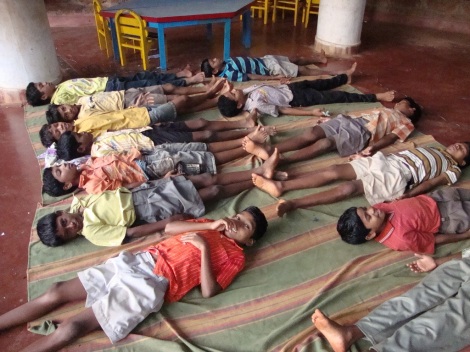
The corpse pose - as you can see, some of these kids were rather 'original' in their interpretation of our instructions
I am off to Delhi for a week; after I come back, we are planning to do a yoga program in one of the prisons of my hometown. It is an ‘open air’ prison – no barbed wires, towers or bars. The inmates live in barracks, grow crops and it is not at all like a prison at all. It should be a great experience.


